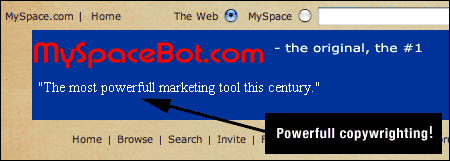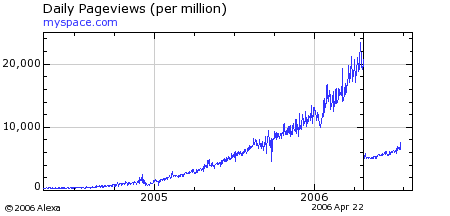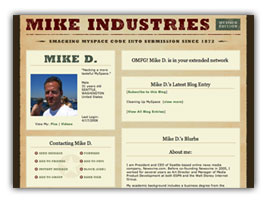Coming To A Town Near You… Maybe.
 I don’t post too often about upcoming speaking gigs because I assume most readers don’t care, but since I have a few coming up, here’s a quick combined rundown. If you’re in town for any of these and want to talk a little shop, let me know:
I don’t post too often about upcoming speaking gigs because I assume most readers don’t care, but since I have a few coming up, here’s a quick combined rundown. If you’re in town for any of these and want to talk a little shop, let me know:
Syndicate Conference – New York City
May 16
Keynote Panel: Grokking the Big Picture: An interview about how syndication is altering the worlds of media, publishing, and marketing.
Speaking with Eric Elia of Brightcove, David Geller of WhatCounts, and Dave Sifry of Technorati.
Interactive Media Conference 2006 – Las Vegas
May 18
Panel: If You Could Build Your Website from Scratch… What Would You Do Differently?
Speaking with Roger Black of Roger Black Studio (OMFG!), Darin Brown of Avenue A/Razorfish, and Lincoln Millstein of Hearst.
WebVisions – Portland
July 21
Session: Designing for Community Interaction.
WebVisions – Portland
July 21
Panel: Design panel.
Speaking with D. Keith Robinson of BlueFlavor, Dan Cederholm of SimpleBits, and Bryan Veloso of FaceBook/Avalonstar.
You Go, Norelco!
 This is probably the funniest product introduction site I’ve ever seen. It’s very well done and whatever agency created it for Philips Norelco should take a bow. Philips Norelco should also take a bow for having the guts to actually run it.
This is probably the funniest product introduction site I’ve ever seen. It’s very well done and whatever agency created it for Philips Norelco should take a bow. Philips Norelco should also take a bow for having the guts to actually run it.
Warning: If you work within earshot of easily offended people, you might want to put on headphones.
It’s the perfect type of campaign for a potentially awkward product like this, and it’s pretty much by definition not offensive to a single person in their target audience.
Anyway, I’m just doing my part to keep this viral. It’s pretty hilarious. Make sure to hit up all the options in the main menu when the intro is over.
Are there many other recent examples of well-done, agency-created viral Flash campaigns? I feel like the memorable ones don’t come around often enough.
Welcome To BotSpace
Another day, another MySpace post. I don’t mean to keep picking on the wildly successful social networking site, but just now, I saw a banner ad which really made me wonder what’s going on over there.
Five minutes ago, at the top of my MySpace profile page, I noticed a large ad for a site called “MySpaceBot.com”. The impressive collection of testimonials fading in and out across the bottom of the ad piqued my interest. A screenshot is below:

Whoa! I know this century is only six years old so far, but “the most powerfull [sic] marketing tool this century”? I had to have a look. Interestingly, the banner led to a site called “Friendbot.com”. Friendbot sells a product that — get this — specifically evades MySpace’s security procedures and performs all sorts of automated actions around the site. Here’s a sample of what evil Friendbot can do:
- Evades CAPTCHAS put in place by MySpace to curb spam
- Imports entire friend lists from anyone inside of MySpace
- Sends automated friend requests that appear to be human-generated
- All sorts of other evil bottish things
Here’s an interesting line from their FAQ:
Will I be banned from MySpace.com for using this program?
No you will not. But if by some miracle you manage to get banned, do not come blame us.


This whole Friendbot thing was starting to seem weird to me, so I dug a little deeper.
IE7 and Search Defaults: Not a Whineable Offense
I can’t believe the amount of chatter around the web today about Microsoft’s plans to include MSN search as the default search option in IE7. What exactly about this is surprising? And what exactly about it is wrong?
I am the last person on earth to give Redmond free passes for anything but this has been coming for years, and it’s perfectly ok in my book. Why is it ok?
- The more incentive Microsoft has to get IE7 proliferated into the population asap (preferably through auto-update), the better off the web development world, and by extension, the internet-using population will be.
- If Google was so concerned about this, why haven’t they used a few hundred million dollars of their war chest over the past year or two to help turbocharge the relatively blasé Firefox adoption rates we’ve seen lately? Google has always said they don’t need to make their own web browser, and they are right… but they *do* perhaps need to make someone else’s irrelevant.
- This is not much different than Microsoft’s decision to make everyone’s default start page “MSN.com” when it released Internet Explorer. If I’m not mistaken, out of all the things Microsoft was judged to be guilty of by the DOJ, that wasn’t one of them. I could be wrong about this, but I just don’t remember that being part of the verdict.
- OEMs can change the search default to whatever provider they’d like, and after that, consumers can change it again themselves (although many, of course never do… see: MSN.com’s 1 trillion daily users).
I suppose I understand why Google is throwing such a huge stink about this, because hey, why not? But in the end, I don’t think it’s anything that should be subject to government intervention. We all hate it when one company dominates any particular sector of business, and in the technology world, that company has usually been Microsoft. But it’s entirely possible that that company is now Google, and although we all love them, competition is almost always a good thing.
ABC Full Episode Streaming is Live… and it’s Spectacular
 Seinfeld fans will note the Teri Hatcher reference in the title of this post, but I just tried out ABC’s full-episode streaming video service which launched a few minutes ago (around 2am this morning), and it is indeed quite nice.
Seinfeld fans will note the Teri Hatcher reference in the title of this post, but I just tried out ABC’s full-episode streaming video service which launched a few minutes ago (around 2am this morning), and it is indeed quite nice.
Lost, Desperate Housewives, Alias, and Commander in Chief. They are all available online now if you live in the U.S. — free of charge. This isn’t some B-reel lineup of shows starving for attention. These are ABC’s most popular programs, and now thanks to Disney Brass, the ABC team in Burbank, and the Disney Internet Group in both Seattle and North Hollywood, they are viewable on any computer with a broadband connection. No more PVR-induced BitTorrenting for me… at least with ABC shows.
I have a special regard for this product because it was the last project I worked on before leaving Disney to start Newsvine. My work was in the proof-of-concept phase and the final product doesn’t share a single line of code or element of design, but I still feel an affinity for what has been accomplished here. I think it’s really, really great.
Some items of importance:
- This service is fully cross-browser and cross-platform. No Internet Explorer/Windows Media mess to worry about. I’m so glad Flash video won out in the end, and although Steve Jobs had nothing to do with it, I’m sure he’s happy that these shows look and work great on Macs.
- This is perhaps the nicest looking Flash video I’ve ever seen. Not only are the video dimensions nice and large, but the picture is extremely clear and not choppy at all. You can tell a lot of work went into the encoding and delivery process. It’s also interesting to note that this is 400k and 700k Flash streaming and not progressive download. Progressive download has been a lot more common than streaming in the past and it’s nice to see such a great example of true broadband Flash streaming in action.
- As great as this service is from a design and engineering standpoint, what’s been accomplished here from a licensing standpoint is just as significant. Disney has wanted to stream television shows for several years now. I remember working on early prototypes a few years ago, but the problem back then was that internet rights had never been negotiated into the deals of the network’s most popular shows. This wasn’t specific to ABC but to all major networks including NBC, Fox, and CBS. Most people think that when a show like Desperate Housewives airs on ABC, the network has full ownership of it. That is not the case. They generally have rights to do certain things with it (viz. air it on TV, sell it on DVD, etc), but only recently have networks begun including internet distribution rights in these deals. It looks like we’re finally starting to see the fruits of these new licensing terms, and it’s a great great thing.
- My only complaint here is the lack of ability to pop the video full screen. I remember talking to Macromedia about this awhile back but can’t remember what their answer was with regards to whether or not they’d ever be able to build this functionality into the Flash plug-in.
- Actually, I have one other complaint and that is that the video is not available internationally, but hey, you have to crawl before you can walk.
So head on over to ABC.com and check this thing out for yourself. I’m sure it’s just the beginning of a lot more video-related initiatives to come at Disney. Big ups to everyone over there and to all the peeps in the Seattle office!
One more thing: I believe this is officially a “trial service” which will run until June 30th. Hopefully it will do well and continue on long after that.
MySpace: Unstoppable Force or Unnecessary Click Factory?
So I just read the big article about MySpace in today’s New York Times and it got me thinking a lot about growth, monetization, and user experience. People always talk so much about how many pages MySpace serves up and how that represents such dramatic growth.
After playing with the thing for a few weeks and writing a hugely ridiculous article on customizing it, one thing has really stuck out to me: there are a tremendous amount of extraneous page views being generated at that place. It’s a factory of unnecessary clicks. And so when one would view MySpace’s current page view trends on Alexa, one would see this:

Here’s a sobering thought: If the operators of MySpace cleaned up the site and followed modern interface and web application principles tomorrow, here’s what the graph would look like:

(Editor’s Note: I originally fat-fingered the first graph above when uploading it and used the Reach graph by mistake. Fixed. Both graphs show the exact same curve, however. Thanks to Owen Thomas of Business 2.0 for the heads-up.)
Read more…
Hacking A More Tasteful MySpace
"line-height: 1px" to "line-height: auto" in the body section of the CSS. A guide to creating a more tasteful MySpace layout. Sample images and CSS are included at the bottom. End product: myspace.com/mikeindustriesThe social phenomenon that is MySpace is one I don’t fully understand, and yet, one I must fully respect. In fact, with over 50 million unique users, it is something everybody must respect. Any website which rolls up that amount of usership is doing something very, very right, and no matter what your thoughts on it as a vehicle for your own expression are, you must give it its full due for what it is to seemingly everyone else.
A guide to creating a more tasteful MySpace layout. Sample images and CSS are included at the bottom. End product: myspace.com/mikeindustriesThe social phenomenon that is MySpace is one I don’t fully understand, and yet, one I must fully respect. In fact, with over 50 million unique users, it is something everybody must respect. Any website which rolls up that amount of usership is doing something very, very right, and no matter what your thoughts on it as a vehicle for your own expression are, you must give it its full due for what it is to seemingly everyone else.
Several weeks ago, I finally signed up for an account, and within seconds I was instantly put-off by what had been created for me: a hastily-designed “profile page” with uninspired colors, misaligned tables, and a mish-mash of extraneous cruft and design elements which made this feel more like a halfway house than a “home”. Now, granted, I am a designer by trade so my tolerance for this stuff is orders of magnitude lower than most of the population, but clearly, this was not a place I even felt comfortable having my name on.
So with the default home page this underwhelming, what is a MySpacer to do? Customize, of course. One of MySpace’s greatest features is its ability to let you skin your own home page. Unfortunately, 99% of the customizations I’ve seen are chalkboard-screechingly awful, but what could a MySpace home page look like if some actual design thought went into it? That is the question I sought to answer.
But first — as Keith Robinson asked me when I first showed him what I was doing — “Ummm, why?” The answer is twofold. First, I love a design challenge. Second, we’ve been building a lot of new social components into Newsvine over the past several weeks and I wanted a good reference point for what is already done well online and what could be improved.
So without further ado, on with the surgery…
Read more…
Fun With Brits
What on earth is going on here? I don’t know, but I couldn’t pass up an opportunity to create another Brit Pack Vanity Fair cover.
Click for a larger image… suitable for wallpaper in size. Questionable, however, in content.
How to Use Gmail over IMAP
I had a very simple idea yesterday to get Gmail to work through IMAP and wanted to share it in case it is of use to anyone else.
Warning: This is clearly not rocket science and I’m positive that thousands of people have already thought of this and are already doing it. It just didn’t occur to me until now.
The problem: I like mail applications better than web-based mail. I am especially not fond of the way Google’s threads work. I understand that this format works for some people… it just feels weird to me though. BUT… a Gmail account is great to have because of its free storage, spam filtering, separation from my own domain, and search capabilities. So very conveniently, Google enabled POP access to Gmail accounts several months ago. That’s great, except I don’t like POP either. It’s fine for people who only use one computer, but the second you begin using a multiple machines, it’s a synching nightmare.
Enter IMAP e-mail. With Dreamhost’s IMAP e-mail setup, I can maintain an unlimited number of e-mail accounts with over 20 gigs of storage space and keep it all automatically synched between as many computers as I want. Awesome.
The only problem is that while Gmail supports retrieving of e-mail via POP, they don’t via IMAP. So what can I do if I want to continue using my Gmail address for filling out forms on the web and benefit from its excellent spam/phishing filters? Easy! Set it to automatically forward to a special IMAP account! Since Gmail’s auto-forwarding feature leaves headers for the most part intact, I can now receive fully synched, fully intact copies of all my Gmail messages to any computer I happen to be on. Here’s how:
- Set up a new IMAP mailbox with your mail provider. The address could be “abcdefg@yourdomain.com”… doesn’t matter. It’s not public-facing.
- Set your incoming mail server to its normal settings.
- Set your outgoing mail server to “smtp.gmail.com”, check “Use SSL”, and use port 465.
- Go to Gmail’s POP/Forwarding settings panel.
- Turn on forwarding and forward to the special address you’ve set up.
- Set Gmail to archive your mail after forwarding.
That’s it. You’re done. Gmail over IMAP. That such an obvious solution has escaped me for this long is evidence of possible senility. Excuse me while I go stir my fiber drink.
I Steal Television Shows Because I Have To
 This morning, via Cory Bergman and Lost Remote, comes word that Charter Communications has been sending letters to their customers telling them to stop BitTorrenting HBO shows. Essentially, HBO has been watching torrents and trackers looking for the IP addresses of everyone who is “sharing” one of their shows. Upon identifying an IP address and associating it with a filename like “The.Sopranos.S06E02.HDTV”, HBO will send a letter to the ISP who owns that IP address urging them to revoke that customer’s internet access altogether.
This morning, via Cory Bergman and Lost Remote, comes word that Charter Communications has been sending letters to their customers telling them to stop BitTorrenting HBO shows. Essentially, HBO has been watching torrents and trackers looking for the IP addresses of everyone who is “sharing” one of their shows. Upon identifying an IP address and associating it with a filename like “The.Sopranos.S06E02.HDTV”, HBO will send a letter to the ISP who owns that IP address urging them to revoke that customer’s internet access altogether.
First let me say that I believe in HBO’s right to stop their shows from being shared online. Sorry, but I do. The Sopranos is property of HBO and the only license they grant is for you to either a) watch it on HBO, or b) buy/rent the DVDs. HBO is a premium channel so you pay for the right to watch their stuff and you don’t have to deal with commercials. Fair enough, as far as I’m concerned.
Notwithstanding the above paragraph, it’s interesting to note the steps that HBO must take in order for them to actually have these letters sent. They must first equip themselves with the same BitTorrent software that they seem to be fighting against. Then, they must seek out these Torrents, and I believe actually participate in them in order to verify that a file named “The.Sopranos.S06E02.HDTV” is actually the Sopranos and not a one-hour home movie from god knows who. So it’s clear they have to actually download the file. This would seem to be illegal, but I guess they’d let themselves off since they own the content. But with BitTorrent, when you download, you also upload, so not only are they sucking the file down to their machines, but they are also willingly distributing it to others. I know the goal is to just catch thieves, but isn’t this very entrapment-like? I don’t want to get any deeper into the legal aspect of this because a) I’m not a lawyer, and b) it’s probably possible to download from BitTorrent without uploading, but I just thought it was interesting.
Throwing HBO aside for a moment though, I’d like to publicly admit to my ISP (Qwest) and the rest of the world that I, too, steal television shows.
My cable provider is Comcast. I pay for a premium package including HDTV, an HD-PVR, way too many channels, and HBO. I watch stuff live whenever I can, and I don’t mind commercials. I take that back. I mind the Applebee’s commercial with the damn Gilligan’s Island theme song parody. I HATE that thing.
Occasionally, however, I am doing other things, such as working, when one of my favorite shows is on. In the past, I have either set my VCR to record these shows or set up the old Season’s Pass on the DirecTivo to do the trick. But since Comcast bugged me time after time to switch away from my DirecTV service and onto their HD Cable Service with PVR (that’s Painfully Volatile Recorder), I now have to rely on the technology Comcast has chosen for me in order to catch Survivor and 24.
So without getting into the ugly specifics of the Comcastorolasoft PVR (I’ve done that three times on this blog already), let me just say that this recorder obeys orders about as reliably as Internet Explorer renders CSS. That is to say, sporadically, sloppily, and at times, without reason. Not only have I missed entire shows but I also missed the final minutes of two extremely important basketball games even though I set the box to record well over the allotted time of the show.
So when you’re in the middle of a season of 24 and you miss an episode because your cable box was too busy, ummmmm, displaying the time, what do you do? What CAN you do? There are no repeats. There are no free downloads for cable subscribers. The only thing you can do is hop on Azureus and BitTorrent yourself the episode you missed.
And that’s what I do. About two or three times a month.
It’s not clear who is at fault here on the technology side so it’s hard to point fingers. It’s either Comcast (the providers of the service), Motorola (the makers of the PVR), or Microsoft (the engineers of the PVR’s operating system). Those who know me would guess I’d be most likely to blame Microsoft — and I do — but the only company I’m willing to give a bit of a free pass to here is Motorola. It’s not clear they have any control over what’s going on. Comcast, on the other hand, does. Even if the cause of this PVR’s instability is the Microsoft OS, they are the ones who approved and continue to approve its use in the Seattle metro area (other areas around the country do not use the Microsoft OS).
So who are the losers in this whole equation?
- TV Advertisers: When I download a show, there are no commercials for me to watch.
- TV Stations: When I download a show, I am not tuned to a TV station, so theoretically, if Neilson homes did this, ratings would go down.
- Everyone involved in creating TV shows: By bypassing the economics of television distribution and monetization, I am decreasing the amount of money in the system and therefore the incentive to create great shows.
- Qwest: Because I am downloading 350 megabyte shows, I am sucking up unnecessary bandwidth from my ISP.
- Me: I hate downloading shows. I have to watch them on my laptop instead of the HDTV and there is often a few day delay in actually procuring the program.
And who are the winners?
The only person I can think of is perhaps the person who doesn’t pay for TV at all and is receiving tons of shows by virtue of this growing TV-sharing environment on the internet.
So what’s the solution to this whole problem? Well, I have a few obvious suggestions:
- Cable companies, please fix your PVRs already. Buy Tivo if you have to. In three years using a DirecTivo, I never missed a show.
- Whether you’re a cable or satellite company, offer as many of your shows on-demand as possible. Comcast offers most HBO shows on demand, so even if I miss an episode, I can view it whenever I want. In other words, Comcast and HBO have seen to it that if you pay for HBO, there is no reason you should ever need to download an HBO show illegally. Good move.
- Continue the policy of prohibiting commercial-free, illegal copies of shows to be distributed over P2P networks but change the game entirely by offering perhaps both pay-per-download and ad-supported versions of shows online.
I have no indication that suggestion number one will happen anytime soon, but numbers two and three are already at various points of development. I can only hope that when these new models mature, the economic model for television will remain viable.
Until then though, I will keep stealing TV as long as technology forces me to.
